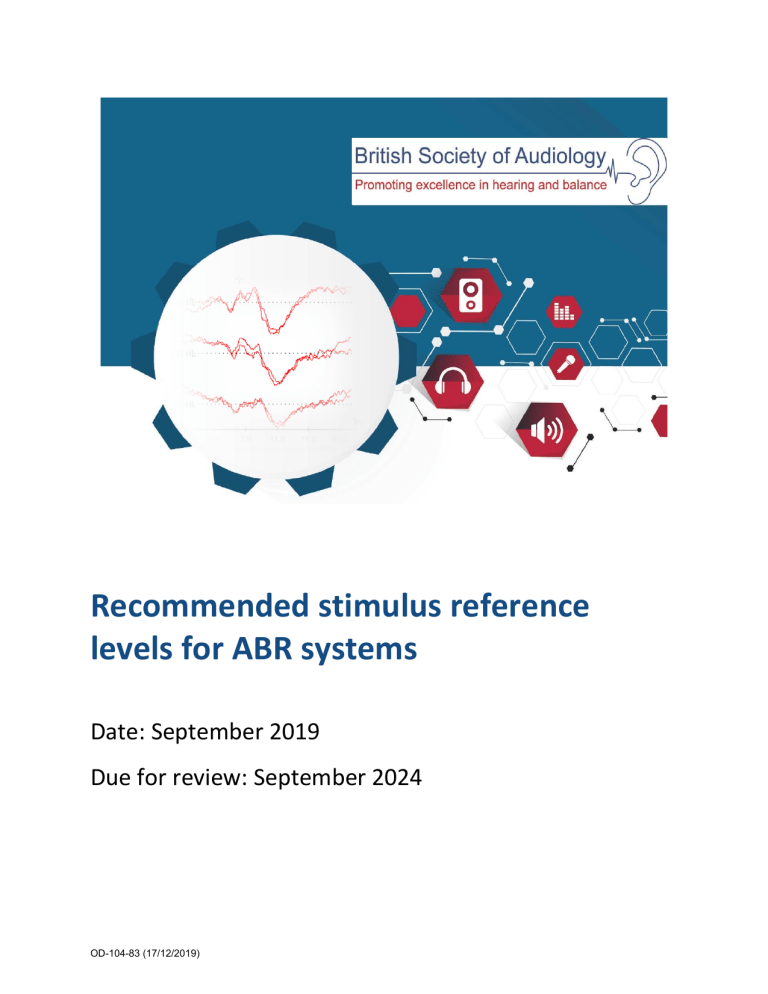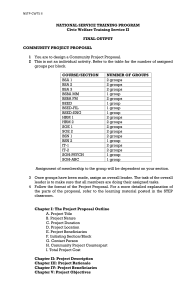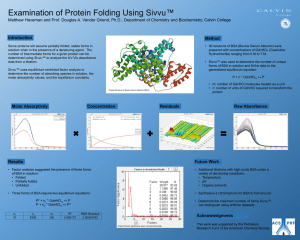
Recommended stimulus reference levels for ABR systems Date: September 2019 Due for review: September 2024 OD-104-83 (17/12/2019) Recommended stimulus reference levels for ABR systems BSA 2019 General foreword This document presents guidelines by the British Society of Audiology (BSA). This guideline, which has been adapted from the document ‘NHSP recommended stimulus reference levels for ABR systems, April 2012, represents, to the best knowledge of the BSA, the evidence-base and consensus on good practice, given the stated methodology and scope of the document and at the time of publication. Although care has been taken in preparing the information supplied by the BSA, the BSA does not and cannot guarantee the interpretation and application of it. The BSA cannot be held responsible for any errors or omissions, and the BSA accepts no liability whatsoever for any loss or damage howsoever arising. This document supersedes any previous recommended procedure by the BSA and stands until superseded or withdrawn by the BSA. Comments on this document are welcomed and should be sent to: British Society of Audiology Blackburn House, Redhouse Road Seafield, Bathgate EH47 7AQ Tel: +44 (0)118 9660622 bsa@thebsa.org.uk www.thebsa.org Published by the British Society of Audiology © British Society of Audiology, 2019 All rights reserved. This document may be freely reproduced in its entirety for educational and not-for-profit purposes. No other reproduction is allowed without the written permission of the British Society of Audiology. Authors & Acknowledgments Produced by: The Electrophysiology Special Interest Group (EPSIG) and has been developed in accordance with BSA Procedure for Processing Documents (2016). OD-104-83 (17/12/2019) Recommended stimulus reference levels for ABR systems BSA 2019 Contents 1. 2. 4 4 4 4 Page 3 3. Abbreviations..........................................………………………………………………………………… Introduction.................................................................………….………………………………… 2.1 Development of the document............................................................................. Recommended stimulus levels....……………………………………………………………………………. © BSA 2016 OD-104-83 (17/12/2019) Recommended stimulus reference levels for ABR systems BSA 2019 1. Abbreviations ABR AC BC IEC ISO NHSP RETVFL RETSPL Auditory brainstem response Air-conduction Bone-conduction International Electrotechnical Commission International Standards Organisation Newborn Hearing Screening Programme (England) Reference Equivalent Threshold Vibration Force Level Reference Equivalent Threshold Sound Pressure Level 2. Introduction 2. 1 Development of the document This document has been adapted from the document ‘NHSP recommended stimulus reference levels for ABR systems’, April 2012, produced by John Stevens & Guy Lightfoot as members of the Clinical Group of the NHSP. The development of this document was undertaken by the members of the Electrophysiology Special Interest Group (EPSIG) and has been developed in accordance with BSA Procedure for Processing Documents (2016). 3. Recommended Stimulus Reference Levels Table 1 gives the reference levels for clicks, tone bursts, chirps and narrow band chirps recommended for use when performing ABR testing. Table 1. ABR Reference Levels for Stimulus Calibration 32.0 22.0 Narrow Band Chirps~ 500 1000 2000 4000 26.5 24.5 30.5 35.0 22.5 18.5 22.0 25.0 Clicks 2:1:2 cycle tone pips (note 6) Chirp 500 1000 2000 4000 B71/B70 & IEC 60373 (will become IEC 60318-6) (note 5) 51.5 69.5 58.5 47.5 53.0 51.5 Narrow Band Chirps~ 500 1000 2000 4000 75.0 61.5 50.0 55.5 ER-3A / IEC 60318-4 (IEC 60711) occluded ear simulator ER-3A / IEC 60318-5 (2cc coupler, HA-2) (note 4) Clicks 35.5 26.5 2:1:2 cycle 500 1000 23.5 21.5 19.5 16.0 BC RETVFL dBppeVFL (re 1uN) for bone vibrators © BSA 2016 OD-104-83 (17/12/2019) tone pips 2000 4000 28.5 32.5 20.0 23.0 27.5 27.5 Chirp Narrow Band Chirps~ 500 1000 2000 4000 26.0 21.5 27.0 30.0 26.0 21.5 27.0 30.0 4 AC RETSPL dBppeSPL for insert earphones (note 3) Chirp Page ABR Reference Levels for Stimulus Calibration AC RETSPL dBppeSPL for supra-aural earphones Clicks 2:1:2 cycle tone pips 500 1000 2000 4000 TDH39 / IEC 60318-1 wideband artificial ear 31.0 23.0 18.5 25.0 27.5 TDH39 / IEC 60318-3 (6cc, NBS-9A) coupler (note 2) 31.0 23.0 18.5 25.0 27.5 Recommended stimulus reference levels for ABR systems BSA 2019 Notes 1. Reference levels in the above table in bold are from ISO 389-6 (2007). Figures not in bold are where no values are available from ISO 389-6(2007) and are those recommended by NHSP. Stimulus rate: 20/s. Adult listeners. 2. If the calibration is made using the same reference values with a 6cc coupler (IEC 6063183) instead of an artificial ear, click and tone pip stimuli intensities are likely to be slightly greater at a given indicated hearing level. The differences are thought to be less than 2 dB. The 6cc coupler is therefore an acceptable alternative to the artificial ear, but if it is used the calibration would not comply with IEC 389-6. 3. Warning: when using inserts, the sound pressure level in a neonate's ear canal is likely to be 10-20 dB greater than it would be in an adult’s ear. This is an effect of canal volume and can mean that the stimulus rises to unsafe levels which can cause cochlear damage. Advice on this and related advice on headphones is covered under maximum stimulus levels in the current BSA Practice Guidance “Guidelines for the early audiological assessment and management of babies referred from the newborn hearing screening programme”. October 2019 4. A 2cc coupler (IEC 606318-5) is an acceptable alternative to an occluded ear simulator although its use does not comply with ISO 389-6. Reference values for the coupler can be derived from those for the ear simulator as follows: Clicks subtract 9.0 dB (Haughton, P. 2006. Int J Audiol 45: 60-65); tone pips subtract 4.0, 5.5, 8.5 and 9.5 dB at 0.5, 1, 2 & 4 kHz respectively (differences in the RETSPLs for continuous tones). The tabulated values for clicks and tone pips have been derived in this way or by direct measurement data where this was available. Page 6. BC tone pip data have been derived by adding differences between the reference levels for tone pips and continuous tones (AC) to the ISO reference force levels (BC) for 5 5. Reference values are for the B71 vibrator. The curved stylus of the B70 does not comply with IEC standards, which specify a plane contact face. Measurements suggest that calibration errors associated with the use of a non-standard (B70) vibrator will be less than 3dB. The above values are also provisionally recommended for the newer B81 vibrator as a study in adults (Keceli and Stenfelt 2018. Int J Audiol. 57(8):577-583) showed no significant difference in wave 5 amplitude or latency between the B71 and B81 vibrators, although to date, there has been no validation study in newborns. © BSA 2016 OD-104-83 (17/12/2019) Recommended stimulus reference levels for ABR systems BSA 2019 continuous tones. (Fedtke & Richter, 2005 and ISO 389-3). Interim values only. 7. The values for chirps and narrow band chirps were derived for ER3A inserts by PTB, Physikalisch-Technische Bundesanstalt. (Fedtke & Hensel, 2008). Test Report (2008-0722), Audiometric headphone, ER-3A, MAICO Diagnostic GmbH. Transfer data were applied to derive equivalent values for other transducer/coupler combinations. 8. The reference levels tabulated above are appropriate when using the peak-peak equivalent measurement method specified in IEC 60645-3 (2007). Equipment should be calibrated at a level that is comfortably above that of the background noise but low enough to avoid the risk of distortion. Recommended levels are 70-80 dBHL (AC) and 3040 dBHL (BC). 9. "Clicks" and "tone pips / bursts" are the reference stimuli defined in IEC 60645-3 (2007). ~ The narrow band chirps referred to are those specified by Elberling, C., and Don, M. (2010). “A direct approach for the design of chirp stimuli used for the recording of auditory brainstem responses,” See Figs 1 & 2. J. Acoust. Soc. Am. 128, 2955-2964. Page 6 10. It is all too easy to introduce calibration errors by failing to correctly account for microphone and artificial mastoid sensitivity values. A Spreadsheet is available from http://abrpeerreview.co.uk/resources.html to perform the necessary calculations from these values. Apparent shifts in calibration values should be checked. If there is any doubt in the calibration methodology used, advice should be sought. Stage A listening checks should be a component of all calibration tests. © BSA 2016 OD-104-83 (17/12/2019)






